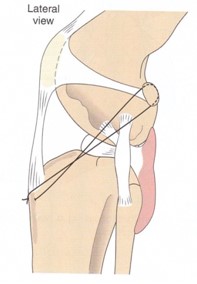ACL/Extracapsular Suture Stabilization (ESS)
Description

The anterior cruciate ligament (cranial cruciate ligament) is a knee ligament that may be torn or ruptured during sudden stopping or twisting movements. The resulting ligament instability causes lameness, pain, and ultimately leads to degenerative arthritis in the knee. Surgical intervention with the extracapsular suture stabilization recreates an artificial ligament in the knee to stabilize the joint.
Indications
There are different types of surgical procedures used to repair ruptured anterior cruciate ligament injuries. An extracapsular suture stabilization procedure is best indicated for cats and small dogs. Animals of this size are less likely to strain or damage the surgical repair as opposed to large dogs that are more likely to stretch or break the sutures. Conformation of the tibial bone is also used to determine which stabilization procedure will work best for an individual patient. Certain tibial deformities place excessive stress on the anterior cruciate ligament, making suture stabilization less effective even in smaller patients.
Postoperative Care
Pain medication is generally only required for the first 10 to 14 days following surgery. Give pain medication only as prescribed and do not give human drugs without first consulting with a veterinarian.
The bandage on your pet’s leg is a soft, padded bandage that controls swelling and provides some support in the early postoperative time. It is not designed to allow running or jumping. The bandage should be checked and/or changed as soon as possible if any of the following are noticed:
- Swelling of the toes occurs
- Bandage becomes wet or soiled
- Bandage has slipped
- Your pet is chewing at the bandage
If your pet has a tendency to chew, then he/she may need an Elizabethan collar designed to prevent chewing. Bandage removal is usually advised three to five days after surgery, but in some cases it may be left on until the time of suture removal.
The long-term success of the procedure depends largely on allowing the leg to rest and heal. Your pet should be confined to a clean, quiet, enclosed area such as a kennel, crate, or small room. Exercise should consist of short walks outdoors only for elimination purposes on a leash. No running or jumping should be allowed for at least two months. Following bandage removal, passive range-of-motion physical therapy is advised to help maintain joint flexibility. If possible, swimming is also helpful after the first four weeks, but check with the surgeon first.
Remember, there is a lot of variation with respect to how soon animals will use the leg following surgery; just because your pet “feels” like running on the leg does not mean that the joint is strong enough to support such vigorous activity.
Please schedule an appointment for suture removal 7 to 10 days after surgery. In addition, please contact us immediately if:
- Bandage problems are noted
- Any unusual swelling is noted
- Discharge of the incision site exists
- Any increase in lameness is noted after pet was starting to improve
- Limping is noticed on any of the other legs
Prognosis
The prognosis for improved function following suture stabilization is good for most small dogs and cats and fair for larger dogs. Extremely active patients are more likely to stretch the repair and have continued lameness and progression of arthritis.
Your pet’s recovery and well-being are our primary concerns, so please do not hesitate to call and speak with a surgical technician or surgeon if there are any questions regarding your pet’s recovery.
Figure 1: Fossum, T., & Duprey, L. (1997). Small Animal Surgery (p. 694). St. Louis: Mosby-Year Book, Inc., Fig 30-69
